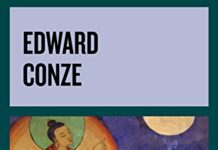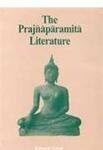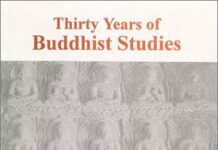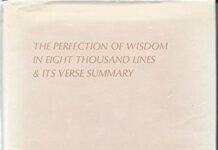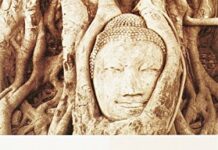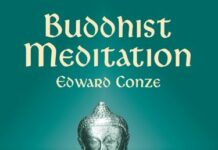
Ebook Info
- Published: 2005
- Number of pages: 697 pages
- Format: PDF
- File Size: 12.18 MB
- Authors: Edward Conze
Description
Some 2000 years ago Buddhism experienced a major reformation through a movement called the Mahayana, or “Great Vehicle,” which dominated religious through in much of Asia for many centuries and still exerts considerable influence. The basic Mahayana texts, sermons ascribed to the Buddha and called “sutras” in Sanskrit, discussed the “perfect wisdom.” The “Large Sutra on Perfect Wisdom” took shape between 50 and 2000 A.D. in southern India during one of the most momentous outbursts of religious creativity in human history.
User’s Reviews
Editorial Reviews: From the Inside Flap “This is a translation of one of the most important expressions of Mahayana Buddhism by the foremost Western authority on the ‘perfect wisdom literature.’. . . . It warrants careful study by anyone wishing to ‘get into’ the thought-world and the experiential frame of reference of Mahayana Buddhism.”–Religious Studies Review “This work, the product of so many years of devotion. . . will be a welcome addition to the library of those interested in Buddhist and comparative philosophy and religion.”–Journal of Indian Philosophy From the Back Cover “This is a translation of one of the most important expressions of Mahayana Buddhism by the foremost Western authority on the ‘perfect wisdom literature.’. . . . It warrants careful study by anyone wishing to ‘get into’ the thought-world and the experiential frame of reference of Mahayana Buddhism.”–Religious Studies Review “This work, the product of so many years of devotion. . . will be a welcome addition to the library of those interested in Buddhist and comparative philosophy and religion.”–Journal of Indian Philosophy About the Author Edward Conze (1904 – September 24, 1979) was an Anglo-German scholar best known for his pioneering translations of Buddhist texts. Read more
Reviews from Amazon users which were colected at the time this book was published on the website:
⭐The author did well in translating the short (“Perfect Wisdom: The Short Prajnaparamita Texts”), mid-length (“The Perfection of Wisdom (in 8000 lines),” & this long text. They address Emptiness (Dependent Arising) in which no thing (dharma) has inherent or own-being (self-existence). Scholars now believe the mid-size version was the first, followed by condensed versions (including the Diamond & Heart Sutras) & lengthier versions (integrated into this work). Versions range from c. 100 BCE to c. 900 CE. Historically, they sought to establish the new Mahayana vehicle as superior to the older Theravada or Hinayana (a pejorative term invented by the Mahayanists) path. Just as Theravada included much Hindu mythology-relegating it to a lower level (realms of the gods such as Brahma), Mahayana included the Hinayana by relegating it to a lower level of enlightenment; later, Tibetans relegated the Mahayana to a lower path than Vajrayana by emphasizing (faster) Tantra over Sutra. Despite Conze’s valuable introduction, these texts are difficult reading due to their erudite concepts & philosophy, terminology, writing style, anachronisms, monotonous repetition (e.g. several renditions of the same conversation), subtlety, poor grammar, questionable choices of English word equivalents, & the basic unevenness of the text (developed over centuries)~the Zohar. They address the profundity of physical/conventional & metaphysical/ultimate reality & their relationship to a Bodhisattva pursuing the Perfection of Wisdom (PoW ) towards full enlightenment (Buddhahood). I particularly liked Chapter 15 describing types of concentrations, 63–Q&A, & 83–clearing up enigmas. “Numerical lists” at the end add clarity, but a precise glossary would have been extremely helpful. Profound highlights-the PoW is much greater than Buddha’s relics etc.; p. 366: the giver/gift/recipient are the same = the conventional world is transitive (has an object) but the ultimate is intransitive (has no object); per psychology–p. 8: “Nirvana…is signless, procedureless, without complexes, the stopping of complexes, by means of cognition;” per Vajrayana–pp. 9-10: “The idea that the thought of the Absolute…is `transparent luminosity’ (pra-bhãsvara)…`thought in its substance is luminous through & through, but has become defiled by adventitious taints;'” ~the Sepher Yetzirah–p. 21: “A mystical alphabet…in some Buddhist circles;” p. 144 note 4: “Emptiness is not a property…it is mere medicine, a means of escape from all fixed convictions. It is taught so that we may overcome attachment, & it would be a pity if we were to become attached to it;” p. 173: “[Bodhisattva] should not take refuge in Buddha, Dharma, & Samgha;” per Dzogchen–p. 211: “Those who learn the doctrine…should wish to be like a magical illusion , to be like a magical creation. In consequence they hear just nothing, study nothing, realize nothing;” intransitive motivation– p. 513: “For the sake of what, then, does [the Bodhisattva] course in perfect wisdom? The Lord: For the sake of nothing whatever;” p. 594: ~Shamatha–“Feeling does not come from anyplace & does not go anywhere;” ~Judaism–p. 669: “8 precepts on the Sabbath;” “mere rule & ritual” are included in the p. 667 “4 bonds (grantha) [also religious fanaticism],” “4 graspings (upãdãna),” & p. 669: “10 fetters (samyojana);” & mindfulness is only one of the p. 668: “7 limbs of enlightenment.” While there is value in reading different (even repetitive) versions of something, the knowledge density of the mid-size version greatly exceeds this one. Thus, readers with limited time are advised to read that version before attempting this one.
⭐If you are ready for this sutra, you will get it. It is long, it is difficult, it is contradictory, it is essential. It is THE original training guide for bodhisattvas and the source of wisdom for many modern-day teachers. Read this so you know for yourself. Nothing compares. If you allow it to teach you, you will learn much.
⭐My review is based on an old out-of-print hardbound copy published 1975. I trust that the softbound edition offered here is essentially the same.About 2000 years ago, 500 years after the Buddha lived, there began to appear in India a series of writings which transformed Buddhism. The oldest of these is The Perfection of Wisdom Sutra in Eight Thousand Lines. It is so revered that it is often depicted sitting on a flower by the left ears of some of the major Buddhist holy beings such as Manjushri, Prajnaparamita, and Je Tsongkhapa. Over the next few hundred years a number of similar but longer Perfection of Wisdom Sutras appeared, in 10K, 18K, 25K and 100K lines. After that a series of condensations then appeared, among them The Diamond Sutra (300 lines) and The Heart Sutra (25 lines). From these writings comes the Mahayana tradition that spread throughout much of northern Asia, evolving into the various forms of Tibetan, Zen and Pure Land Buddhism. The major contributions of this new body of literature were twofold: first, the introduction of a new spiritual ideal, the “Bodhisattva”, who sacrifices his own personal Nirvana in order to stay around and help others; and second, a more profound and radical philosophy of “emptiness”, or ultimate reality.Edward Conze’s book is a compilation of the longer Perfection of Wisdom writings. The result of thirty five years of effort, this book is a grand and scholarly work. Mr. Conze translated and compared many renditions of these longer sutras found in Sanskrit, Chinese and Tibetan, and then sought to blend them into a coherent, unified text. It is the only such English translation of these magnificent and seminal works, and Mr. Conze has certainly done English-speaking Mahayanists a great service through his considerable efforts and knowledge. Having said that, however, I need to point out some serious caveats.First, Mr. Conze, as he was often quick to point out himself, did not understand the meaning or import of many points in the text. These texts are intrinsically difficult to understand, but the main problem is that he was merely an academic, not someone familiar with the practice of Buddhism. and so Mr. Conze often resorted to literal translations of terms and phrases. The result is often a very difficult read, with incredibly awkward grammar and bizarre, frustrating word choices that make even some of the simpler concepts seem quite cryptic. This made worse by all the culturally unfamiliar embellishments, and by the endless repetitions found in old Buddhist literature, which was originally an oral tradition where such repetitions were helpful. It can often be rather slow going, and if you don’t already know what’s being talked about, you might easily become quite lost, and/or bored.Second, this certainly is not an introductory text. It requires a firm grasp of basic Buddhist tenets and world views. In particular, if one does not clearly understand the basics of the older Thervadin teachings one cannot clearly know what these Mahayana teachings are attempting to refute, reinterpret and transcend. I cannot imagine getting much out of this text without a firm grounding in the Visuddhimagga and the more important books of the Abhidhamma. A solid familiarity with the Mahayana, especially with the seeming paradoxes and intricate arguments of the “wisdom teachings” on emptiness, and an ongoing daily practice under the guidance of a qualified teacher would also help.If, indeed, one needs to know most of the material in the book before one reads the book, then why bother? As a practitioner of Buddhism, it has been important for me to go back and study the source texts of my tradition in order to validate and deepen my understanding of the more modern commentaries and oral teachings on which my practice is based. This fosters not only a better intellectual understanding, but, by removing certain subtle layers of doubt, it allows a stable certainty to develop that quiets the mind, allowing it to penetrate more deeply and clearly into Buddha’s most profound teachings. Mr. Conze’s Large Sutra on Perfect Wisdom has been a great aid in this way, and, despite its shortcomings, I recommend it highly.
⭐The Prajnaparamita sutras are exceptionally profound Mahayana Buddhist texts that are by no means easy to understand. In attempting to read them it soon becomes apparent that the author or authors of these texts were scholastics who were thoroughly schooled in the intricacies of Indian Buddhist thought.It also becomes clear that they must have been spiritual aristocrats, persons who had in fact achieved Enlightenment and who, though scholars, were writing from the point-of-view of the Enlightened. Given this, these texts present us with certain problems.Edward Conze (1904-1979) has been called “the foremost Western scholar of the Prajnaparamita literature” and it seems to me that he has in his various works (such as, for example, his
⭐and to a lesser extent in the present book) gone as far as it is possible for a scholar to go in explaining these difficult sutras to a modern audience. I also feel that his many translations of the Prajnaparamita far surpass most others in their clarity and beauty.I first acquired Conze’s ‘Large Sutra on Perfect Wisdom’ many years ago, have always treasured it, and although preferring for most purposes the much more approachable 8000 line version (
⭐I have no hesitation in recommending it.
⭐If there was one book of wisdom teachings we should have on our bookshelf this book The Prajnaparamita (Mother of the Buddha’s) is it, a perennial blessing. Be happy folks.
Keywords
Free Download The Large Sutra on Perfect Wisdom: With the Divisions of the Abhisamayalankara (Volume 18) (Center for South and Southeast Asia Studies, UC Berkeley) in PDF format
The Large Sutra on Perfect Wisdom: With the Divisions of the Abhisamayalankara (Volume 18) (Center for South and Southeast Asia Studies, UC Berkeley) PDF Free Download
Download The Large Sutra on Perfect Wisdom: With the Divisions of the Abhisamayalankara (Volume 18) (Center for South and Southeast Asia Studies, UC Berkeley) 2005 PDF Free
The Large Sutra on Perfect Wisdom: With the Divisions of the Abhisamayalankara (Volume 18) (Center for South and Southeast Asia Studies, UC Berkeley) 2005 PDF Free Download
Download The Large Sutra on Perfect Wisdom: With the Divisions of the Abhisamayalankara (Volume 18) (Center for South and Southeast Asia Studies, UC Berkeley) PDF
Free Download Ebook The Large Sutra on Perfect Wisdom: With the Divisions of the Abhisamayalankara (Volume 18) (Center for South and Southeast Asia Studies, UC Berkeley)
